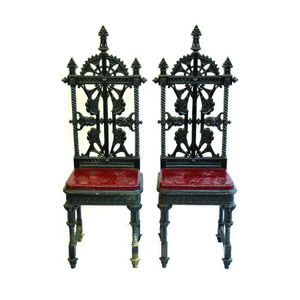Victorian Cast Iron Hall Chair
You must be a subscriber, and be logged in to view price and dealer details.
Subscribe Now to view actual auction price for this item
When you subscribe, you have the option of setting the currency in which to display prices to $Au, $US, $NZ or Stg.
- Turning - Any part of a piece of furniture that has been turned and shaped with chisels on a lathe. Turned sections include legs, columns, feet, finials, pedestals, stretchers, spindles etc. There have been many varieties and fashions over the centuries: baluster, melon, barley-sugar, bobbin, cotton-reel, rope-twist, and so on. Split turning implies a turned section that has been cut in half lengthwise and applied to a cabinet front as a false decorative support.
- Basket Weave / Basketweave - Basket weave is a decorative pattern that is often used in textiles, ceramics, furniture and other decorative arts. It is created by actual or simulated interweaving of horizontal and vertical threads or strips to create a pattern that resembles a woven basket.
In textiles, basket weave can be created using various materials such as fabric, yarn, or ribbon. It is often used to create decorative details on clothing, upholstery, and other household items. Simulated basket weave can also be created using ceramic clay, timber or other materials, and it is often used to decorate pottery, tiles, furniture, silver and other decorative objects.
Basket weave patterns can vary in complexity, from simple, straightforward designs to more intricate, elaborate patterns. The size and spacing of the interwoven threads or strips can also be varied to create different effects. Basket weave is often used to create a natural, rustic look and is often associated with traditional crafts and folk art. - Turned Legs - are legs which have been turned on a lathe. In use from the 16th century, turned legs on tables, chairs and cabinets became more frequent until, by the 1830s, the Georgian square or tapered leg was rarely found except in country pieces.
- Pierced Decoration - Ornamental woodwork with part of the background cut through and removed to produce an open-work pattern.
- Victorian Period - The Victorian period of furniture and decorative arts design covers the reign of Queen Victoria from 1837 to 1901. There was not one dominant style of furniture in the Victorian period. Designers used and modified many historical styles such as Gothic, Tudor, Elizabethan, English Rococo, Neoclassical and others, although use of some styles, such as English Rococo and Gothic tended to dominate the furniture manufacture of the period.
The Victorian period was preceded by the Regency and William IV periods, and followed by the Edwardian period, named for Edward VII (1841 ? 1910) who was King of the United Kingdom and the British Dominions and Emperor of India for the brief period from 1901 until his death in 1910.
This item has been included into following indexes:
-
chairs, singles / pairs / threes, style or period
- hall 212
- Victorian, other styles 1,179
- chairs, singles / pairs / threes, timber - metal, iron, wire etc. 56
Visually similar items

A pair of Coalbrookdale cast iron hall chairs designed by Christopher Dresser c.1870 in the 'Lily' pattern, the decorative backs with a combination of fluted, fan and wrythen forms, conforming base, the cast iron seats with enamelled dark red brown button

A set of four William IV mahogany spade back chairs, circa 1830s, in rich deep tones, the chairs with gently arched cresting rails and scroll and acanthus carved mid rails to wedge shaped drop in seats, with hole to hole cane underneath, and supported on s

A French Empire giltwood and green marble centre table, late 18th/early 19th century, 115 cm wide, 57 cm deep, 95 cm high

A late Victorian ladies writing desk, in various veneers. The upstand back with mirror and small drawers, turned legs. Height 99 cm. Width 76 cm. Depth 43 cm
